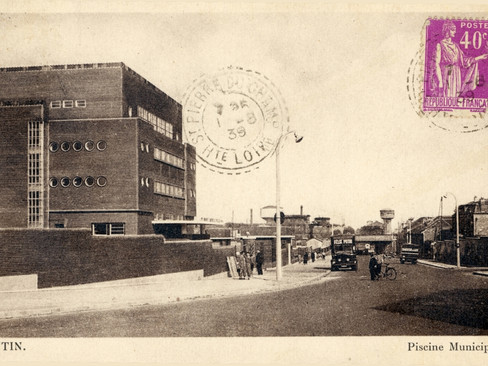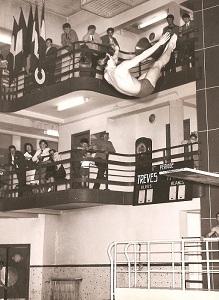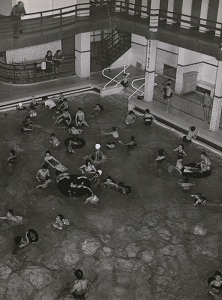The revival of the Alice Milliat swimming pool
- EG-xiste
- Jan 8, 2023
- 6 min read
On Saturday October 18, 2022, the Alice Milliat swimming pool in Pantin, formerly " Leclerc ", was officially inaugurated by the mayor of the city and the president of the East agglomeration together. After two years of restoration and rehabilitation in the rules of the art, it regains its luster and elegance of yesteryear.
I invite you to browse the history of this swimming pool and discover, together and through images, the revival of this jewel of municipal architecture from the 1930s.

The story
Despite the 1924 Olympic Games in Paris, the delay taken by France in terms of sports equipment still remains to be made up, particularly in comparison with Great Britain and Germany.
The many SFIO-labeled mayors recently elected in many municipalities in the Paris suburbs show a real desire to create municipal collective services integrated into the city and close to its inhabitants. This progressive movement of urban policy will trigger the development of public sports buildings in the municipalities of the inner Parisian belt.
The Pantin swimming pool is one of the most remarkable achievements of these urban programs emerging in the interwar period.
Modern architecture from the thirties
The mayor of Pantin Charles Auray entrusted the construction of the swimming pool to his son Charles , a pupil of Georges-Henri Pingusson and to the engineer Jean Molinié (Compagnie Générale des Eaux).
Work began in 1936 and was completed a year later.
The project is sporty and industrial. Indeed the pool will be supplied with water by the pumping plant of the CGE built a few meters from it. It will therefore benefit from warmer and less calcareous water coming directly from artesian wells.
The architecture of this double program is very strongly inspired by that of the Netherlands and more particularly by Willem Marinus Dudok (City Hall of Hilversum and the Bijenkorf store in Rotterdam ). It is fully in line with the architectural modernity of the thirties.
We find the same references there, a massive building like a bunker softened by a set of horizontal and vertical volumes made of advances and withdrawals of bays.
The reinforced concrete structure is covered with a filling of red bricks from the Comptoirs tuiliers du Nord , a material very commonly used at that time in the Paris suburbs.
The facades have no supporting role.
The long horizontal bays in a ribbon cross the entire length of the building and their presence demonstrates that the load descents are not on the facade but inside the building.
The presence of oculi (portholes) on the external spans of the main entrance constitute the only external decorative elements breaking with the austerity of the whole. Bays and oculi are almost all framed by a band of black glazed sandstone.
The interior of the swimming pool revolves around a long longitudinal axis, lit by a glass roof which provides overhead light. At its ends, on one side a main entrance equipped with a semi-cylindrical box and on the other a diving board.
The swimming pool is surrounded by common changing rooms. Four staircases arranged at each corner of the basin provide access to the passageways of the two floors which serve more than two hundred and thirty individual cabins. The corridors served as stands during sporting events organized on the site.

The interior decoration is carried out with care, with modern interior lining materials and extensive use of polychrome ceramics. The principle of the atrium is retained.
Since its inauguration in 1937, the swimming pool has been a great popular success. Success largely caused by the numerous advertising campaigns of the municipality and the appointment of the French swimming champion Jean Taris as director of the establishment.
A progressive decay
Since its commissioning, the swimming pool has not undergone any major modification or restoration and has deteriorated over the years. Despite its inclusion in the supplementary inventory of historic monuments (ISMH) in 1997, the entire building without exception suffered the ravages of time and experienced more and more alterations.
2016, the exterior facades in an advanced state of disrepair. Rainwater had gradually infiltrated the building, passing behind the bricks and thus degrading the reinforced concrete skeleton. Bricks that have taken on water break under the effect of frost. Nets are installed on the main facade to prevent them from falling.
The interior fittings are no exception. The humidity, the frost, the wear and tear of time have done their work, the paint is chipped, the walls are porous, the roof is weakened.
The second life
Thirteen years later begins the major rehabilitation project. After two years of restoration and upgrading, the swimming pool, which has regained its former glory, is returned on July 2, 2022 to pantinois.
It now bears the name " Alice Milliat Pool ". chosen after consultation and consultation with the pantinois. A unanimous tribute to one of the great activists of international women's sport.

The exterior facades
The wide and sober porch of the main entrance with its staircase, ramps and concrete canopy. It is divided by a partially glazed convex volume in the shape of a horseshoe. Inside, this space forms a loggia which accommodates fixed tiled benches.

View of all the completely restored facades. The facing bricks have regained their orange-red colors, as well as the black sandstone elements that highlight all the bay windows.
The oculi with their pivoting frames naturally evoke the portholes of ocean liners and the aquatic function of the place.
The vertical joints are almost invisible, while the horizontal ones are strongly pronounced and hug the building's vanishing line.
The side stairs are arranged on each facade, side and rear. They are partly out of work and lit over their entire height by a corner glass roof.
Interior design
And here is the result of the remarkable renovation work carried out inside the swimming pool. The objective was to remain faithful to the 1937 version while respecting the constraints linked to the standards of our time (hygiene, safety, access for people with reduced mobility).
This careful and spectacular rehabilitation restores the building to its original theatricality.
The combination of half-height white paving bordered by a blue demarcation line and terrazzo confirms the modernist hygienist spirit of this architecture from the 1930s.

The watchwords here, simplicity, elegance and overall harmony.

The glass roof (ceiling and glazed roof with double slope) matches the size of the pool and regains its function of natural overhead lighting.

A view of the galleries that serve the individual cabins on two floors. The openwork doors that hide the equipment stored at pool level help to maintain the elegance of the place.
The entry hall
A floor and a light wall band in "opus incertum" in light beige porcelain stoneware.
The loggia which separates the entrance from the exit and the rounded box, equipped with windows allowing full visibility of the entrances/exits and the pool.
Around the bassin
Around the bathers' sidewalk, with equipment storage space on one side and loggias with recessed benches on the other.
Stairs
The access stairs to the showers and corridors.
Corridors and cabins
The passageways leading to the individual cabins with their blue ironwork railings on blue-toned stucco cornices.
The balconies located on the floors at the entrance once served as stands for the public during sports performances.
Other details
Shower areas, signage and accessories.
The clock, one and only "interior decoration" of the swimming pool remains. The diving board initially located at its feet has long since disappeared because it was no longer up to standard.
Alice Milliat (1884 - 1957)
Here is the new name of the swimming pool "Leclerc" chosen after consultation and consultation with the Pantinois. A unanimous tribute to one of the great activists of international women's sport.
A multi-card sportswoman, swimmer, rower and field hockey player, young bride and very quickly widowed, Alice Milliat favored rowing, which she practiced at Fémina Sport, a club in the 14th arrondissement of Paris. In 1915 she became president of the club.
Then began her activism for the promotion, recognition and access of women's sport in international events and more particularly at the Olympic Games.
Faced with multiple refusals from the IOC, she founded the International Women's Sports Federation in 1921 and began to organize international women's competitions. Under his leadership, the first Women's World Games were held in Paris in 1922.

The growing success during the four successive World Games forced the International Olympic Committee to authorize women's access to the premier category of the modern Olympic Games: athletics.
In return, he decided to put women's sporting events under the supervision of organizations run by men and had the Women's Sports Federation absorbed by the International Athletics Federation.
Anyway, Alice Milliat will have won her legitimate fight for the recognition of women's sport. The city of Pantin legitimately pays tribute to him by associating his name with its magnificent renovated swimming pool.
The Pantin swimming pool was one of the most modern in the Paris region in the 1930s. True witness to the dynamism of social architecture in the field of public facilities, it remains however little known today.
The new Jacques Higelin conservatory built together with the renovation of the swimming pool now forms a unique ensemble. Indeed the two facilities communicate with each other and have a common lounge. We wish them the success they deserve.
Thanks
I wanted to thank Emeric Courteille, manager of the Alice Milliat swimming pool and his entire team for their welcome and kindness during my visit.
© Photos E.G. (unless indicated)























































































































コメント